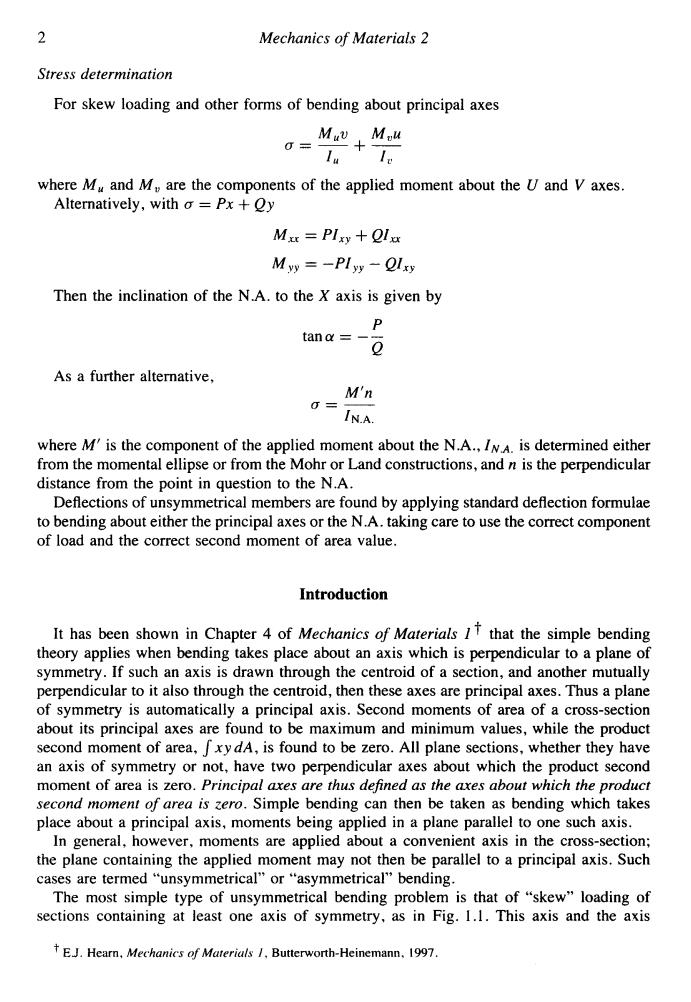正在加载图片...

2 Mechanics of Materials 2 Stress determination For skew loading and other forms of bending about principal axes a=Mi Mou where M and M,are the components of the applied moment about the U and V axes. Alternatively,with a Px+Oy Mxt PIxy +Qlx Myy=-Plyy -Qlxy Then the inclination of the N.A.to the X axis is given by P tana = 0 As a further alternative, M'n 0三 IN.A. where M'is the component of the applied moment about the N.A.,IN.A.is determined either from the momental ellipse or from the Mohr or Land constructions,and n is the perpendicular distance from the point in question to the N.A. Deflections of unsymmetrical members are found by applying standard deflection formulae to bending about either the principal axes or the N.A.taking care to use the correct component of load and the correct second moment of area value. Introduction It has been shown in Chapter 4 of Mechanics of Materials I that the simple bending theory applies when bending takes place about an axis which is perpendicular to a plane of symmetry.If such an axis is drawn through the centroid of a section,and another mutually perpendicular to it also through the centroid,then these axes are principal axes.Thus a plane of symmetry is automatically a principal axis.Second moments of area of a cross-section about its principal axes are found to be maximum and minimum values,while the product second moment of area,fxy dA,is found to be zero.All plane sections,whether they have an axis of symmetry or not,have two perpendicular axes about which the product second moment of area is zero.Principal axes are thus defined as the axes about which the product second moment of area is zero.Simple bending can then be taken as bending which takes place about a principal axis,moments being applied in a plane parallel to one such axis. In general,however,moments are applied about a convenient axis in the cross-section; the plane containing the applied moment may not then be parallel to a principal axis.Such cases are termed "unsymmetrical"or"asymmetrical"bending. The most simple type of unsymmetrical bending problem is that of"skew"loading of sections containing at least one axis of symmetry,as in Fig.1.1.This axis and the axis EJ.Hearn,Mechanics of Materials 1.Butterworth-Heinemann.1997.2 Mechanics of Materials 2 Stress determination For skew loading and other forms of bending about principal axes M,v M,u c=-+- 1, 1, where Mu and M, are the components of the applied moment about the U and V axes. Alternatively, with 0 = Px + Qy M, = PI,, + QIM Myy = -Plyy - QIxy Then the inclination of the N.A. to the X axis is given by P tana! = -- Q As a further alternative, M’n 1N.A. o=- where M’ is the component of the applied moment about the N.A., IN.A. is determined either from the momenta1 ellipse or from the Mohr or Land constructions, and n is the perpendicular distance from the point in question to the N.A. Deflections of unsymmetrical members are found by applying standard deflection formulae to bending about either the principal axes or the N.A. taking care to use the correct component of load and the correct second moment of area value. Introduction It has been shown in Chapter 4 of Mechanics of Materials 1 that the simple bending theory applies when bending takes place about an axis which is perpendicular to a plane of symmetry. If such an axis is drawn through the centroid of a section, and another mutually perpendicular to it also through the centroid, then these axes are principal axes. Thus a plane of symmetry is automatically a principal axis. Second moments of area of a cross-section about its principal axes are found to be maximum and minimum values, while the product second moment of area, JxydA, is found to be zero. All plane sections, whether they have an axis of symmetry or not, have two perpendicular axes about which the product second moment of area is zero. Principal axes are thus de$ned as the axes about which the product second moment of area is Zero. Simple bending can then be taken as bending which takes place about a principal axis, moments being applied in a plane parallel to one such axis. In general, however, moments are applied about a convenient axis in the cross-section; the plane containing the applied moment may not then be parallel to a principal axis. Such cases are termed “unsymmetrical” or “asymmetrical” bending. The most simple type of unsymmetrical bending problem is that of “skew” loading of sections containing at least one axis of symmetry, as in Fig. 1.1. This axis and the axis EJ. Hearn, Mechanics of Murerids I, Buttenvorth-Heinemann, 1997